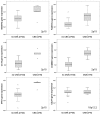Deregulation of COMMD1 is associated with poor prognosis in diffuse large B-cell lymphoma
- PMID: 24625556
- PMCID: PMC3953211
- DOI: 10.1371/journal.pone.0091031
Deregulation of COMMD1 is associated with poor prognosis in diffuse large B-cell lymphoma
Abstract
Background: Despite improved survival for the patients with diffuse large B-cell lymphoma (DLBCL), the prognosis after relapse is poor. The aim was to identify molecular events that contribute to relapse and treatment resistance in DLBCL.
Methods: We analysed 51 prospectively collected pretreatment tumour samples from clinically high risk patients treated in a Nordic phase II study with dose-dense chemoimmunotherapy and central nervous system prophylaxis with high resolution array comparative genomic hybridization (aCGH) and gene expression microarrays. Major finding was validated at the protein level immunohistochemically in a trial specific tissue microarray series of 70, and in an independent validation series of 146 patients.
Results: We identified 31 genes whose expression changes were strongly associated with copy number aberrations. In addition, gains of chromosomes 2p15 and 18q12.2 were associated with unfavourable survival. The 2p15 aberration harboured COMMD1 gene, whose expression had a significant adverse prognostic impact on survival. Immunohistochemical analysis of COMMD1 expression in two series confirmed the association of COMMD1 expression with poor prognosis.
Conclusion: COMMD1 is a potential novel prognostic factor in DLBCLs. The results highlight the value of integrated comprehensive analysis to identify prognostic markers and genetic driver events not previously implicated in DLBCL.
Trial registration: ClinicalTrials.gov NCT01502982.
Conflict of interest statement
Figures




References
-
- Coiffier B, Lepage E, Briere J, Herbrecht R, Tilly H, et al. (2002) CHOP chemotherapy plus rituximab compared with CHOP alone in elderly patients with diffuse large-B-cell lymphoma. N Engl J Med 346: 235–242. - PubMed
-
- Habermann TM, Weller EA, Morrison VA, Gascoyne RD, Cassileth PA, et al. (2006) Rituximab-CHOP versus CHOP alone or with maintenance rituximab in older patients with diffuse large B-cell lymphoma. J Clin Oncol 24: 3121–3127. - PubMed
-
- Pfreundschuh M, Schubert J, Ziepert M, Schmits R, Mohren M, et al. (2008) Six versus eight cycles of bi-weekly CHOP-14 with or without rituximab in elderly patients with aggressive CD20+ B-cell lymphomas: a randomised controlled trial (RICOVER-60). Lancet Oncol 9: 105–116. - PubMed
-
- Pfreundschuh M, Trumper L, Kloess M, Schmits R, Feller AC, et al. (2004) Two-weekly or 3-weekly CHOP chemotherapy with or without etoposide for the treatment of young patients with good-prognosis (normal LDH) aggressive lymphomas: results of the NHL-B1 trial of the DSHNHL. Blood 104: 626–633. - PubMed
-
- Pfreundschuh M, Trumper L, Osterborg A, Pettengell R, Trneny M, et al. (2006) CHOP-like chemotherapy plus rituximab versus CHOP-like chemotherapy alone in young patients with good-prognosis diffuse large-B-cell lymphoma: a randomised controlled trial by the MabThera International Trial (MInT) Group. Lancet Oncol 7: 379–391. - PubMed
Publication types
MeSH terms
Substances
Associated data
LinkOut - more resources
Full Text Sources
Other Literature Sources
Medical
Molecular Biology Databases

